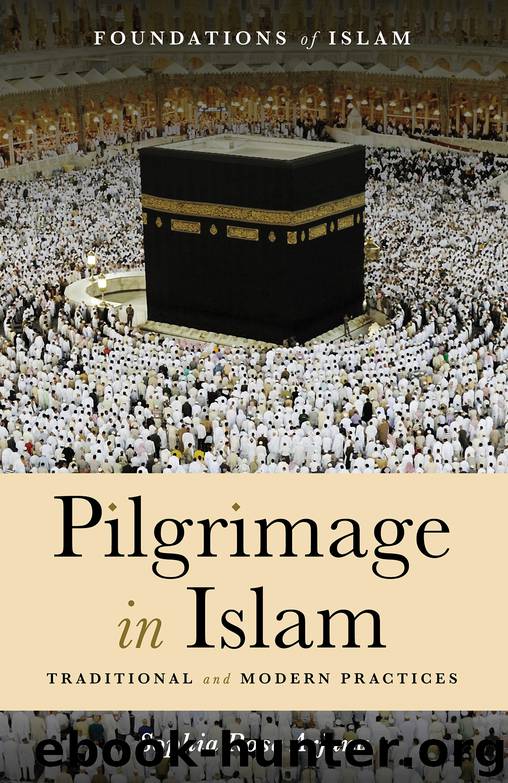Pilgrimage in Islam by Sophia Rose Arjana

Author:Sophia Rose Arjana [Arjana, Sophia Rose]
Language: eng
Format: epub
ISBN: 9781786071170
Publisher: Oneworld Publications
TOMBS AND MAUSOLEUMS
Pilgrimage to shrines housing relics and the bodies of the relatives of Prophet Muhammad, teachers, shaykhs, mystics, political leaders, and others are so common in Islam that it would be impossible to catalogue every site. The popular saying of Egyptian Muslims, “God has forbidden the earth to consume the bodies of the saints,” reflects the importance that Muslims place on the dead.74 In Iran, followers of Shaykh Safi believed in this so strongly that his son’s ablution water was viewed as “imbued by beneficial effect, as tabarruk” (blessed).75 Many pilgrimages involve visiting a relic of the Prophet, such as a hair, a piece of clothing, or a sandal (na’a al-nabi), objects many wished to be buried with and that were believed to emit barakah. The veneration of the Prophet’s sandal is documented in historical records and other sources in the Maghrib, Egypt, Syria, and Turkey, suggesting that the practice of visiting the Prophet’s relics has been widespread for quite some time.76
As we have seen, the belief that the body of an individual remains powerful after death is widespread in Islam. This is not a belief restricted to Shi‘i or to Muslims who practice traditions associated with Sufism. For many Muslims, the saint, shaykh, or other venerated individual is “virtually alive, not only in spirit but in body as well.”77 And the saint’s body is not the only location of power. Numerous sites include a sacred field of space radiating from the grave or tomb that encloses a large landscape with barakah. In Bangladesh, even the natural wildlife that surrounds the shrine (often called a majar, from the Arabic mazar) is considered holy. The black soft-shell turtles attached to the shrine of Sultan-ul-Arefin Bayzid Bostami are special because it is believed “that these turtles were brought and introduced to the Bostami pond by the Sufi himself.”78
The tradition of constructing tombs is not restricted to saints. In many cases Muslims visit the graves of important teachers and intellectuals, ancestors or companions of the Prophet and his relatives. Damascus alone is the site of the graves of three of Muhammad’s wives as well as Bilal ibn Hamama (the first me’edhdhin – that is, the first person who gave the call to prayer), Abu al-Darda, Fadala ibn Ubayd, Sahl ibn Hanzaliyya, and other companions of Muhammad.79 These tombs are found in many places including graveyards and madrasahs that were often, but not always, associated with Sufi turuq (orders). The construction of tombs in madrasahs was done, in part, to discourage the practice of praying at a grave, out of fear that it might lead to “idolatry of the dead.”80 Of course, Muslims ended up doing this anyway, disregarding the concern of the ulama who wanted to regulate prayer and guarantee their position in society through the madrasah.81 The madrasah was composed of the iwan (an open hall), khalwah (lodgings for students and teachers), and the junayna (courtyard), but typically had a number of ancillary attachments – a library, a Sufi monastery, an orphan’s school, and a tomb.
Download
This site does not store any files on its server. We only index and link to content provided by other sites. Please contact the content providers to delete copyright contents if any and email us, we'll remove relevant links or contents immediately.
The History of Jihad: From Muhammad to ISIS by Spencer Robert(2509)
Nine Parts of Desire by Geraldine Brooks(2284)
The Turkish Psychedelic Explosion by Daniel Spicer(2249)
The First Muslim The Story of Muhammad by Lesley Hazleton(2159)
The Essential Rumi by Coleman Barks(1933)
1453 by Roger Crowley(1882)
The Last Mughal by William Dalrymple(1797)
Trickster Travels: A Sixteenth-Century Muslim Between Worlds by Davis Natalie Zemon(1786)
Muhammad: His Life Based on the Earliest Sources by Martin Lings(1569)
God by Aslan Reza(1565)
by Christianity & Islam(1564)
A Concise History of Sunnis and Shi'is by John McHugo(1519)
Magic and Divination in Early Islam by Emilie Savage-Smith;(1462)
No God But God by Reza Aslan(1438)
The Flight of the Intellectuals by Berman Paul(1402)
Art of Betrayal by Gordon Corera(1368)
Nothing to Envy by Barbara Demick(1330)
What the Qur'an Meant by Garry Wills(1329)
Getting Jesus Right: How Muslims Get Jesus and Islam Wrong by James A Beverley & Craig A Evans(1279)
